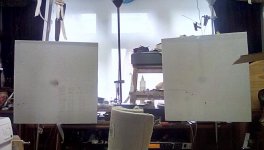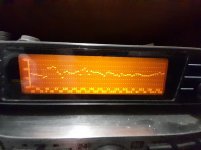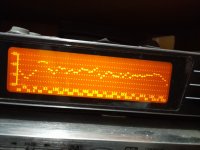JohnnoG.
Not that much difference between these two types of mounting(on this panel).
The first picture has a good frequency response from about 100hz and upwards to 20k.
The second picture also has a good response from 100hz but it rises to a peak above 10k and then drops off at about 16k.
This panel only let's my exciters go down to 40hz with the usual hump at about 60hz.
Ignore everything below 40hz as this is road noise.
Steve.
Not that much difference between these two types of mounting(on this panel).
The first picture has a good frequency response from about 100hz and upwards to 20k.
The second picture also has a good response from 100hz but it rises to a peak above 10k and then drops off at about 16k.
This panel only let's my exciters go down to 40hz with the usual hump at about 60hz.
Ignore everything below 40hz as this is road noise.
Steve.
Attachments
JohnnoG.
No problem👍
I was just passing wickes and had a look at 2mm proplex.
It is far too floppy to be any use for a panel I believe.
Don't forget you can have a panel that is too rigid also.
your 6mm panel is only about 5db down from my LQ crate ply panels, so they should be fine for my exciters as I would roll them off at , at least about 100hz ?
I have just stuck the exciter in the centre ,but will try offsetting the second panel to see what happens.
I would not usually make a square panel ,but as I have them, I might as well give them some tests to see how this material reacts.
Steve.
No problem👍
I was just passing wickes and had a look at 2mm proplex.
It is far too floppy to be any use for a panel I believe.
Don't forget you can have a panel that is too rigid also.
your 6mm panel is only about 5db down from my LQ crate ply panels, so they should be fine for my exciters as I would roll them off at , at least about 100hz ?
I have just stuck the exciter in the centre ,but will try offsetting the second panel to see what happens.
I would not usually make a square panel ,but as I have them, I might as well give them some tests to see how this material reacts.
Steve.
I have found a Spec' Sheet and a product from Amazon as seen in the link.
I am assuming when looking at the Spec Sheet, the 3.2mm Flute Spacing at approx' 400g - 500g per m2, will be a board with a improved rigidity over the commonly seen Correx.
It really is looking a hands on assessment is the best method to make a choice, as lesser grams per m2, can easily mean easy manipulation of the material.
https://www.antalis.co.uk/mediashare/g4media/pdf/TS_EN_CORREX_00_21062013.PDF
https://www.amazon.co.uk/sheets-correx-plastic-polypropylene-display/dp/B016DYFSEO
I am assuming when looking at the Spec Sheet, the 3.2mm Flute Spacing at approx' 400g - 500g per m2, will be a board with a improved rigidity over the commonly seen Correx.
It really is looking a hands on assessment is the best method to make a choice, as lesser grams per m2, can easily mean easy manipulation of the material.
https://www.antalis.co.uk/mediashare/g4media/pdf/TS_EN_CORREX_00_21062013.PDF
https://www.amazon.co.uk/sheets-correx-plastic-polypropylene-display/dp/B016DYFSEO
Hello JohnnoGI have found a Spec' Sheet and a product from Amazon as seen in the link.
I am assuming when looking at the Spec Sheet, the 3.2mm Flute Spacing at approx' 400g - 500g per m2, will be a board with a improved rigidity over the commonly seen Correx.
It really is looking a hands on assessment is the best method to make a choice, as lesser grams per m2, can easily mean easy manipulation of the material.
https://www.antalis.co.uk/mediashare/g4media/pdf/TS_EN_CORREX_00_21062013.PDF
https://www.amazon.co.uk/sheets-correx-plastic-polypropylene-display/dp/B016DYFSEO
Thank you for all your research on such alternative material. There was already a tentative in the direction of plastic cardboard by Maxjerry (#4293, p215) but I don't remember having seeing how is the result.
In a range of material like that, I think it is not easy to say which one is the right one as we are looking for a couple: mass, bending stiffness. The mass is a parameter we can easily read in specifications or evaluate. The bending stiffness remains not so intuitive for me. The question is how low to go low with the mass without having a to "floppy" panel as I think Steve wrote.
But by the way, this is not my main question about this family of panel... the main one is they are made of polypropylene which means for me difficult to glue... is it right? Doing a quick research (on the net) says a glue for plastic should work (glue for non porous material).
As a consequence : is there a possibility of a nice finishing ?
I have also in mind for loudspeaker made of polypropylene some bad frequency response when the cone comes to break up (lack of internal damping?).
Christian
Hi Spedge - The 60Hz hump seems quite common - do you have any theories as to why?This panel only let's my exciters go down to 40hz with the usual hump at about 60hz.
Eucy
Hide Glue
My curiosity was piqued by the hide glue comments and I ordered some pearl to try (one can never have too many raw materials in the workshop 😉 )- I also found a link to making liquid hide glue - pdf copy of article attached together with a more general article. OBG (Old Brown Glue) is apparently hide glue made the same way with added urea to extend the open time
More info here: https://www.oldbrownglue.com/index.php
Fascinating to see it still has many uses and positive characteristics.
Cheers
Eucy
My curiosity was piqued by the hide glue comments and I ordered some pearl to try (one can never have too many raw materials in the workshop 😉 )- I also found a link to making liquid hide glue - pdf copy of article attached together with a more general article. OBG (Old Brown Glue) is apparently hide glue made the same way with added urea to extend the open time
More info here: https://www.oldbrownglue.com/index.php
Fascinating to see it still has many uses and positive characteristics.
Cheers
Eucy
Attachments
@ homeswinghome As a consequence : is there a possibility of a nice finishing ?
There are aerosol spray primers referred to as Plastic Primers. Once this primer is applied, the other paint finish options is vast.
It may also be compatible as a base for other coating materials as well.
There are aerosol spray primers referred to as Plastic Primers. Once this primer is applied, the other paint finish options is vast.
It may also be compatible as a base for other coating materials as well.
Maybe I had better correct myself, when I said that the 2mm proplex is too floppy ,I was referring to larger panels.
For use as a smaller panel as I have done with other 2mm materials ,the propped could be ok ?
I just do not want to buy a 4ft x 2ft panel just to test a 9inch x 6inch panel 😁
Steve.
For use as a smaller panel as I have done with other 2mm materials ,the propped could be ok ?
I just do not want to buy a 4ft x 2ft panel just to test a 9inch x 6inch panel 😁
Steve.
Christian.
I could try and force off the exciter with a Stanley knife to see how good the pva glue holds the exciter.
or are you more interested in paints that can be used ?
Steve.
I could try and force off the exciter with a Stanley knife to see how good the pva glue holds the exciter.
or are you more interested in paints that can be used ?
Steve.
Christian.
polypropylene seems to have a lot of self damping but not a lot of rigidity.
I am very aware of the sound mainly coming from the exciter area , how far this extends out from the exciter , and what frequencies , I can not guess.
cone polypropylene speakers had a bad sounding break up , probably down to the lack of strength an rigidity , not self damping.
Steve.
polypropylene seems to have a lot of self damping but not a lot of rigidity.
I am very aware of the sound mainly coming from the exciter area , how far this extends out from the exciter , and what frequencies , I can not guess.
cone polypropylene speakers had a bad sounding break up , probably down to the lack of strength an rigidity , not self damping.
Steve.
Hello Steve,Christian.
I could try and force off the exciter with a Stanley knife to see how good the pva glue holds the exciter.
or are you more interested in paints that can be used ?
Steve.
No hurry in my questions... more curiosity. Conduct the tests of this material as you have it in mind. Reading here and there about polypropylene I am surprised of the possibility to glue it with PVA. If you have the opportunity to check the resistance at end of a test cession it will be interesting.
Christian
SteveChristian.
polypropylene seems to have a lot of self damping but not a lot of rigidity.
I am very aware of the sound mainly coming from the exciter area , how far this extends out from the exciter , and what frequencies , I can not guess.
cone polypropylene speakers had a bad sounding break up , probably down to the lack of strength an rigidity , not self damping.
Steve.
I read a bit more about PP in cone speaker. You are right the material is said to have a good self damping but a lack of bandwidth in cone applications. Such limitation seems not visible on your tests, is it right?
Gluing is listed in the difficulties of this technology in its first times.
I have been fortunate in discovering and acquiring sample pieces, of a sheet of the ribbed/fluted plastic protection material that is Thinner than the commonly used Correx type sheet, and more important has a denser material, that is quite rigid in comparison.
I am approximating it @ 500g per m2, where the on test fluted sheet is approx' 1200g per m2.
I have Six Sample pieces of 600mm x 600mm at a gross weight of 2050g.
These will be sent on to Steve, to be tried out in Dimensions that suit the tests.
I am approximating it @ 500g per m2, where the on test fluted sheet is approx' 1200g per m2.
I have Six Sample pieces of 600mm x 600mm at a gross weight of 2050g.
These will be sent on to Steve, to be tried out in Dimensions that suit the tests.
Christian.
I will leave it a week or two and see if the exciter falls off.
Normally I sand the surface a little to give the pva something to grip on to, but I forgot !
But I did clean the surface with alcohol first , hic.
Steve.
I will leave it a week or two and see if the exciter falls off.
Normally I sand the surface a little to give the pva something to grip on to, but I forgot !
But I did clean the surface with alcohol first , hic.
Steve.
Christian.
I'm not sure how far the hf travel's across the panel ?
Or what level it is, if it reaches the edges ?
I'm a bit busy at the moment, but hopefully at the weekend I can do some tests.
The polystyrene panel flexes while playing, which is no problem.
But very bad for a cone speaker , I should think.
Steve.
I'm not sure how far the hf travel's across the panel ?
Or what level it is, if it reaches the edges ?
I'm a bit busy at the moment, but hopefully at the weekend I can do some tests.
The polystyrene panel flexes while playing, which is no problem.
But very bad for a cone speaker , I should think.
Steve.
I had a buddy in historical recreation who made his own hide glue, then made a kind of wooden sled with it using no other form of bonding or nails, just surface to surface glue and then had his daughter ride the sled towed by their two giant wolfhounds. The demonstration of the power of hide glue was very dramatic.
- Home
- Loudspeakers
- Full Range
- A Study of DMLs as a Full Range Speaker


